I leave Tan-Tan plage quite late and my objective is still to cycle across the Sahara. There are 200 kilometers until Tarfaya and those should be more “desertic” than the previous road with relatively many cafés and field work for a desert.
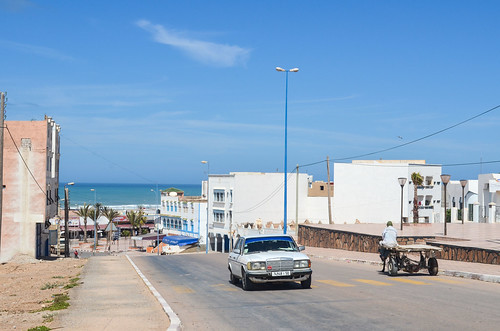
It can seem not motivating to cycle the desert against the wind, however I always find some things to enjoy. At least the milestones, and sometimes bonuses.
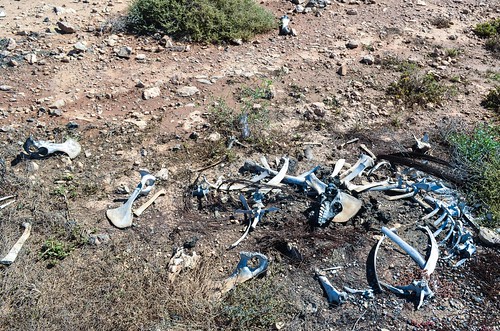
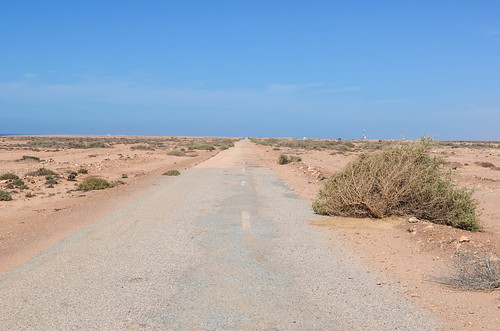
I am stopped after only 30 km at a road security checkpoint to take my passport details. All foreigners are stopped and recorded, and apparently those on a bicycle are given extra attention. While chatting with the gendarme, we go through the list of all recently passed foreigners, and I get to know that the closest cyclists are 2 French on a recumbent bicycle who passed here 10 days ago.
I didn’t even manage to drink more than 1.5 L that I can already refill my bottles, the Chbika checkpoint having a mini shop. Chbika is a place where the oued Chbika is joining the Atlantic Ocean, and there is a big sign with the Orascom (Egypt) logo for a future luxury city right here. There is currently nothing but stones and sand. It is planned to host a Club Med, and visiting the colorful official website makes me smile when all I see on site is a few cement silos and one truck moving, and only 2 years left until the official opening.

As I get close to the sea (the road being parallel to it 100 meters away), I notice that there is no beach, but the whole coast is a cliff. It jumps steep into the water about 50 meters below me. As it has become the rule when I feel that I am finally for real in a remote inhospitable place, I spot far away a small settlement of fisherman just down the cliff.
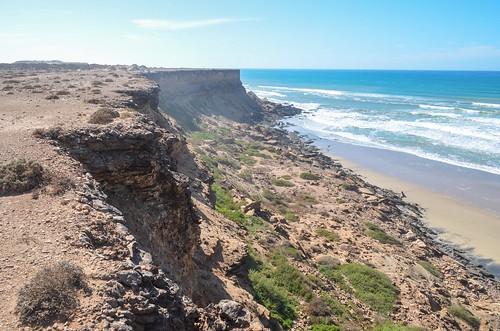
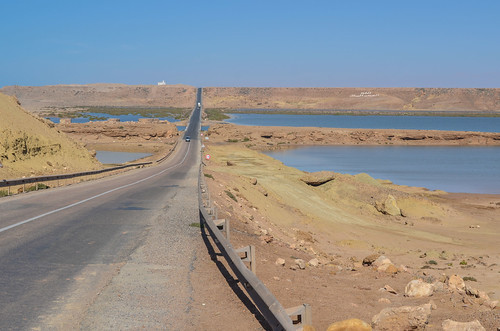
The wind is still against me and I maintain a speed around 12 km/h, with peaks up to 18 km/h if it stops. I pass the time by sometimes spotting herds of goats, camels, and camper vans. The road is straight but not entirely flat. For a desert, there are many oueds (rivers) coming from the interior. As the route is 50 to 100 m above sea level, each time I have to cross a oued, the road goes down to a bridge, and up again.
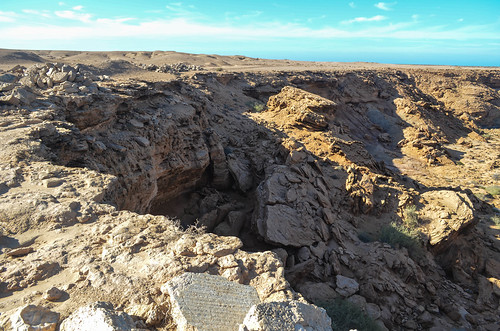
Just at the camping-spot-searching time, I reach again two petrol stations. I am starting to think that this Sahara is much friendlier and hospitable than I thought. I had read blogs of cyclists advising to take 8 or 10 liters of water, and so far I never got to use more than 1.5 L before a refill place. There is a shop, a café, mosque, … everything one needs. There is also a gendarmerie checkpoint. The gendarme advises me not to stay around the petrol stations, because it’s “unsafe”, but rather to cycle back 500 meters down into the Oued El Waaer and camp with the fishermen.
The two fishermen are staying in huts made of pieces of wood and plastic tarps, and welcome me to set up my tent on the sand nearby. We agree to meet for breakfast, while I get to my tent, already completely wet from the ocean breeze and surrounded by bugs who appeared out of nowhere.
For those who have already camped and woken up to their bags infested by ants, they know they should never fall asleep with bags open or food at reach of animals. I had sealed my supposedly waterproof bags but am greeted from inside them by a beautiful white sand spider.

We breakfast together with the fishermen in their actually well built shack. But they are not fishermen. They are from the military. They tell me their rank, hard to believe when seeing them, and say they are controlling the coast.
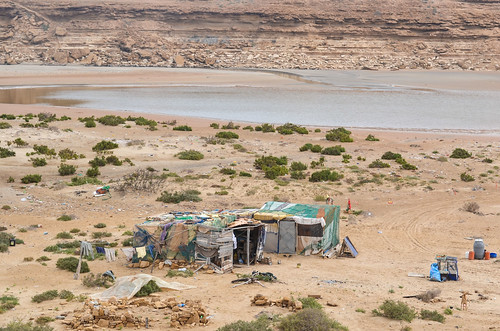
Nothing in their outfit or dwelling could let me think they are in service, only the army costume hanging inside. They make sure no one from Morocco or other African countries set departure from sand of the oued to the Canary Islands, Spain or Italy. The Canary Islands are just a bit more than 1 hour boat away. I had heard Europe was paying Morocco to make them control the illegal departures from their own coast, but I was not expecting the money was spent in paying people to live in shacks and watch the sea.

So my day starts at the gendarmerie checkpoint of Oued El Waaer, with a not so nice gendarme.
The road is still following the ocean a few dozen meters away. One can’t realize from the road how steep are the cliffs.
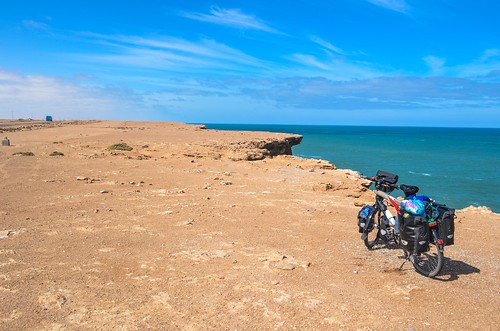
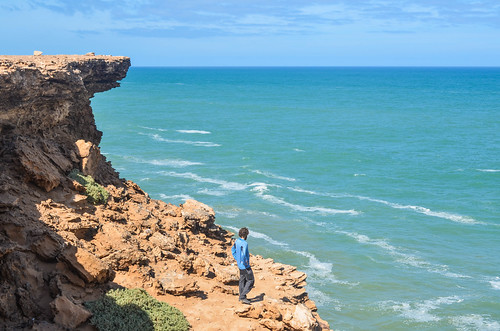
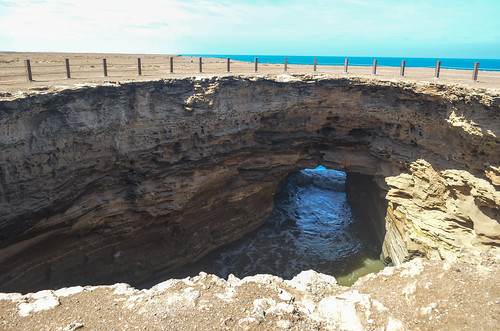
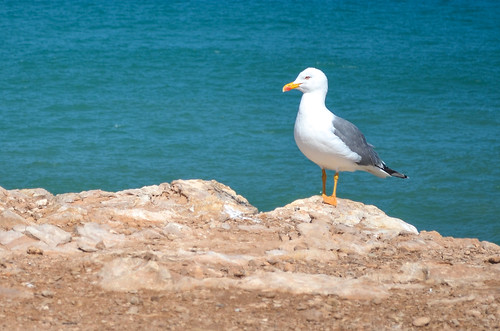
I quickly cycle the 25 kilometers to Akhfenir, a town halfway between Tan-Tan and Tarfaya, that I wanted to reach yesterday. This town is a perfect stop to split the 200 km journey and once again, for a desert, has everything. Akhfenir is small enough to be entirely laid along the main road, but big enough to have more than 20 or 30 restaurants. Despite the early hour for lunch, I pick a restaurant and get to choose my fish among many in the cold storage room. Morocco is turning for me into a fish paradise and I can leave behind the kefta meat balls. There is even a hotel and the 3G network here. But it is not a reason to stay, and I leave for Tarfaya, still 100 km further, at the same time 8 buses full of army men on their way south stop in Akhfenir for lunch.

Just at the exit of Akhfenir begins the National Park of Khenifiss. I am not expecting much from it, knowing that it will still be a desert road, and the entrance sign maintenance speaks for itself.
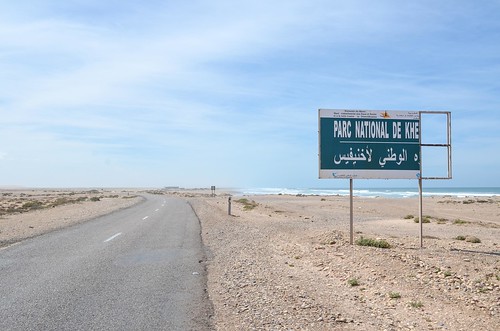
However, the road is more pleasant than usual. There are many sand dunes (and it’s way more pleasant than stones on a flat ground) and a lagoon. The lagoon is partly dry and we can see the white traces of the salt at the bottom of it.
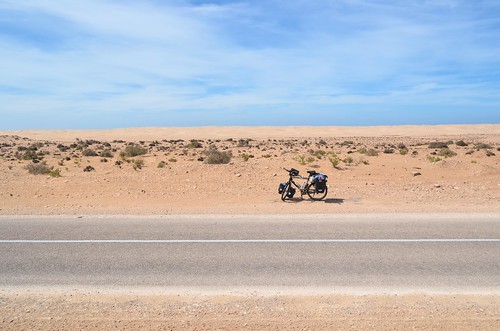
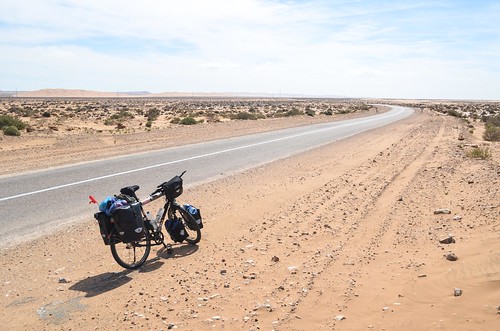
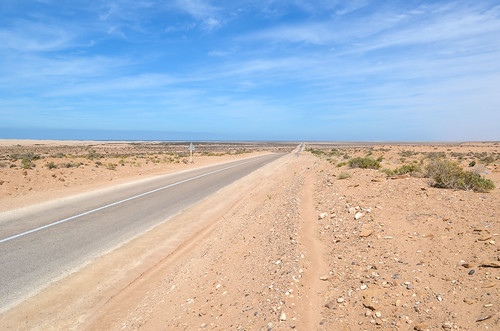
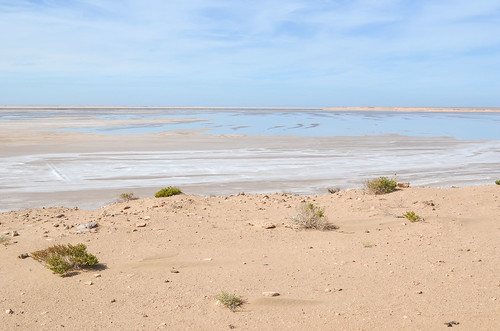
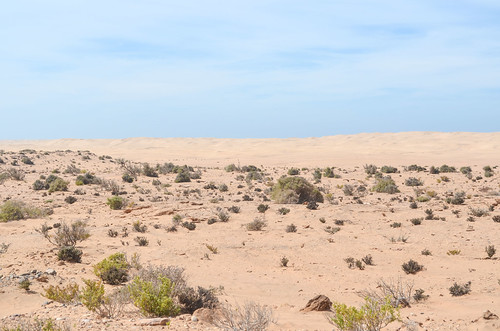
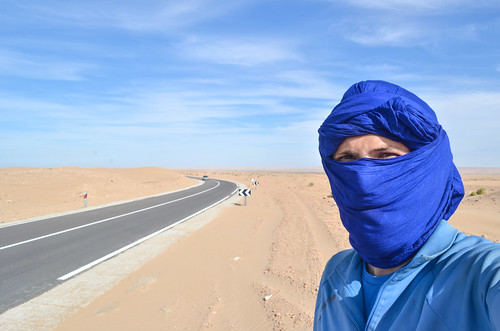
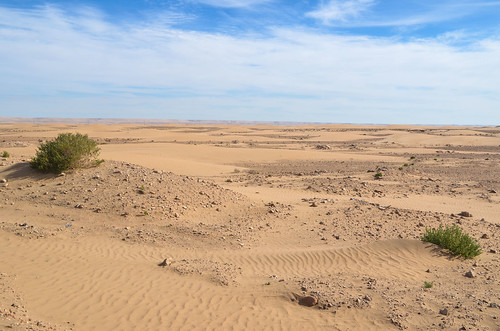
With the sand, it feels more being into a real desert. The sand portion ends as I reach the southern limit of the Khenifiss National Park. The road is very boring for drivers making the 500 km or 1000 km journey until Laayoune or Dakhla. It has long stretches of straight road connected by slight bends. Almost every of those turns are indicated by a sign, useless, unless the driver is sleepy or drunk enough to have veeeery long reaction time.
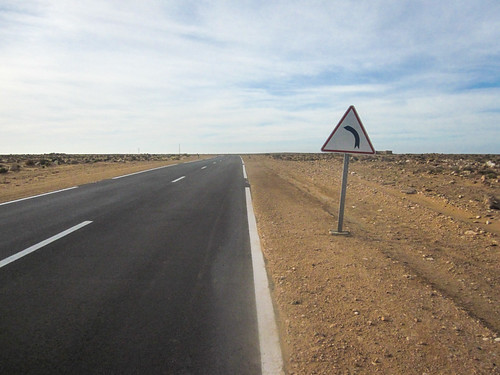
There is road café at KM 60 after Akhfenir, limiting the longest water-less stretch so far to this easily manageable distance. I have still 25 km to make until Tarfaya but will not be able to do it tonight. If only the wind was blowing in the right direction …
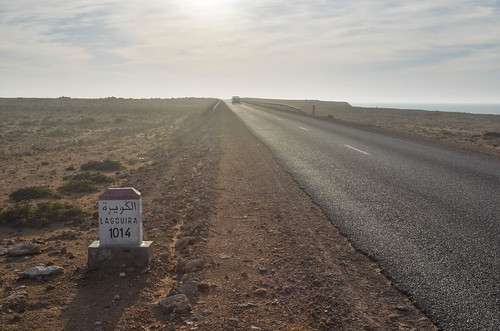
On my right, between the road and the coast, the land is occupied by houses every kilometers. They are all the same size, same structure, same water tank on the roof top at the same position … it looks like something from the army.
And bingo, when the men at one of those houses wave at me and make me come by, they are indeed from the army auxiliary forces watching the coast. It happens just when the sunset is pushing me to find a camp spot and I waste no time in setting up my tent by their house.

They say that the coast is this way guarded every kilometer until Boujdour, which is 300 km further. They live 3 or 4 into those standard houses, with 2 rooms, a little kitchen and a little toilet/shower. Their job is the same as the men of my previous night, to watch the coast for the illegal immigrant boats. They say they are mainly Africans from Senegal, Mali, and countries more south, taking the sea at 20 or 30 on a Zodiac boat until the Canary islands. I cannot see those islands, 100 km away, but when the night comes, the light pollution from Lanzarote or Fuerteventura becomes apparent.
I cannot make a feast of my tomatoes, bread, pasta, cucumber, (disgusting) mortadella, milk, as I was thinking for the whole afternoon, since they are inviting me to eat dinner with them and refuse to share my food. I am carrying too much food for a Sahara road too densely inhabited. So we eat while watching the Rennes – St. Etienne football game. We can be in the desert, but they have a solar panel powering 2 televisions at night and a card to access many channels. Al Jazeera has at least 10 sports channels broadcast here and we can watch football games from almost any European league.
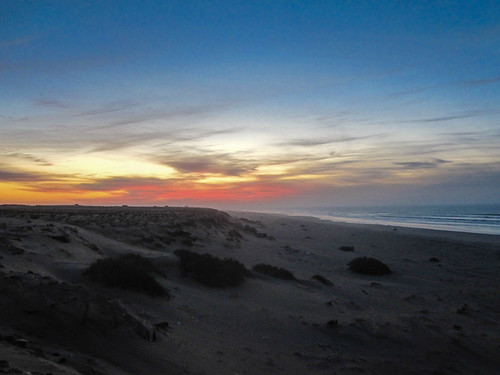
Football is big and the officer knows many of the players of the French Ligue 1. I’d say the chances to get illegally to the Canary Islands increase tenfold on a foggy evening of a clasico Real Madrid – Barcelona. The only one really working is the dog barking to all moving things. At the same time as other nights, some stars are much higher than before. The temperatures are just right for cycling, needing my jacket only in the evening.
I get a surprising visit at night. While on my laptop, the gendarmerie royale officers come to my tent. They ask for my “fiche” and my GPS coordinates. Many of the officials here expect a “fiche” from the foreigners, which is a passport photocopy or a simple paper with passport details, so they don’t have to copy it. I made a couple of photocopies but am not handing them out (for doing it every 30 or 50 kilometers, I’d need at least 20 of it), as usually the process to note down the information from the passport is quite quick. This time, at night and naked in my tent, is the right time to hand out the fiche and let them go away. The army officer had called them so they can ensure my security. I was surprised and annoyed at first to be tracked and recorded several times a day, but they constantly repeat that I am safe in the Sahara and that they look after my security, always very politely and with the greatest attention, that it feels good to be so well considered by the authorities.
However, those authorities being still authorities not very able to reply to a question starting with “Why”, I don’t know why the army officer comes later to tell me to switch off my headlight. And got annoyed later when he visits me again to tell me to switch off my laptop, as he could probably see the light from outside. That is making me delayed in picture sorting and blog writing.
In the morning, we breakfast together before I go and visit the shipwreck on the beach. According to the military, it was a boat used for illegal immigration. When I get to it, I discover that Winnie the Pooh is the one sadly aground …

Note from 2020: I received a very interesting message from Itay, who said:
I was part of a 3 men crew who sailed this yacht and had to abandon it near the coast of Morocco due to a combination of a semi-broken mast and severe weather. I don’t know why they said that, since one of us came back to the boat to take all the stuff and equipment we left there.
My ambitious objective is the big city of Laayoune, capital of the Western Sahara, 125 kilometers away. I first have to get to Tarfaya at the Cape Juby, then make a 90° turn left and go south. I count on the fact that the headwind will disappear after this sharp turn and will be able to get closer to a 20 km/h average.
So I leave early and motivated, still against the wind. I am stopped after 3 kilometers only to take down my details. This time it is from the auxiliary forces, in cooperation with the gendarmerie.
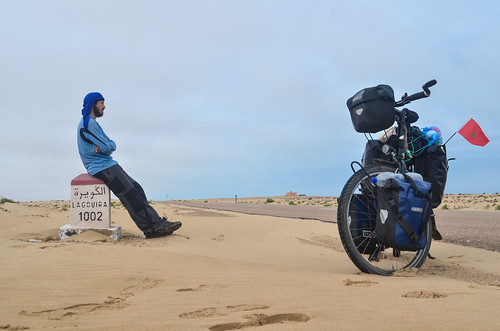
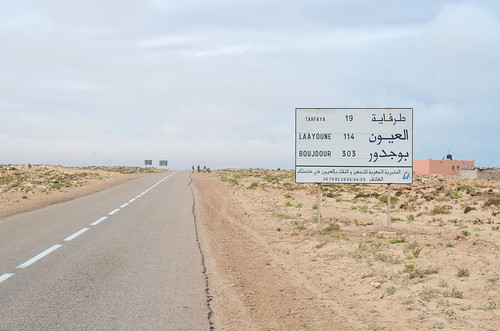
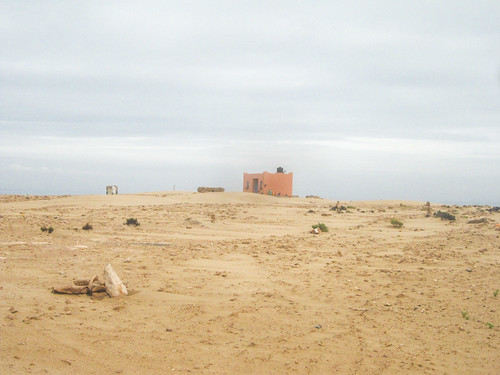
I reach Tarfaya around noon as expected. The weather is not good and the atmosphere in Tarfaya not welcoming. The city looks either in construction, either run down, but for sure quite ugly. The city center of this 5’000 inhabitants town is tiny but it has Milka chocolate, so I’m fine.
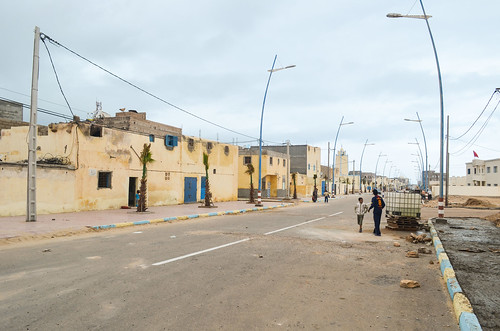
I sit in a café to eat one of my 4 chocolate tablets supposed to power me up for the rest of the day. This just when it starts raining. I watch the rain in this gloomy town knowing that I will have to take the road under the light rain. A gendarme approaches me to ask for my passport. At my reply “For the 3rd time within 25 km?”, he makes a phone call, enumerates all my passport details, and wishes me a good and safe journey. Out of the two roads leaving to Laayoune, the N1, the main interior one, and the small coastal one, he advises me to take the main one because it’s better, without sand, and has less truck traffic. This sounds like a big lie “for my safety”. But anyway, the wind and rain coming from the west, I am thinking of taking the main road to hope for less humidity.
Fortunately the rain doesn’t last, and I make a little tour in this little town. There is a little monument to honor Saint-Exupery who was appointed station manager in1927 when Tarfaya was on the route of the Aeropostale.

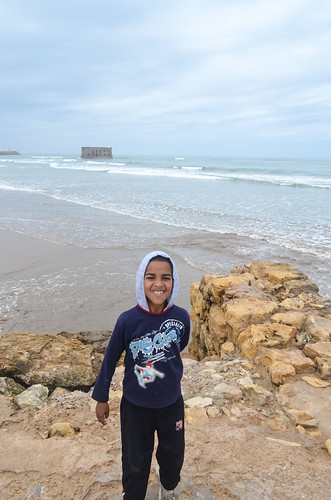

The north of the town is blocked for visitors as it seems heavily occupied by the army. The port of Tarfaya is open but of little interest. My only last “thing to check” before heading to Laayoune is the shipwreck of the ferry that used to make the trip between Tarfaya, Morocco and Fuerteventura, Canary Islands, Spain.
The shipwreck lays since 2008 by the coast 2 km south of Tarfaya, along the coastal road. This road is a new road linking Tarfaya to Foum el Oued, thus avoiding Laayoune, and entirely paved. When I get to the shipwreck, I don’t feel like making a U-turn to return to the main N1 road to Laayoune, so I just continue ahead. That should make a few extra kilometers, but be much more quiet and more scenic than the interior road.
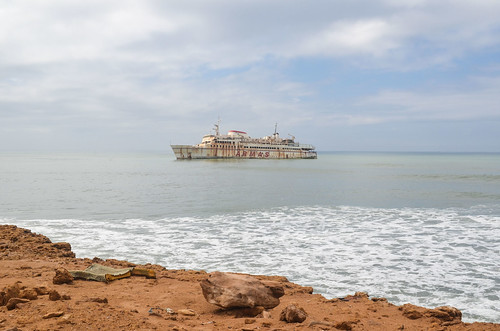
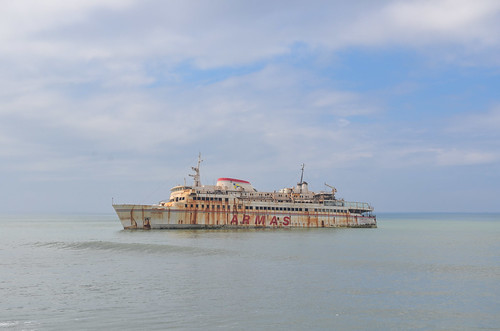
The road is pleasant and as expected, much quieter than the main one. The unbelievable comment from the gendarme was indeed wrong. The “dangerous” sand taking over the road, that he mentioned, is not preventing the few truck to go through, so it won’t stop my bicycle. There are still the same army houses by the coast every kilometer. It is impossible to run out of water along this Sahara-crossing road, as there are many people living along.
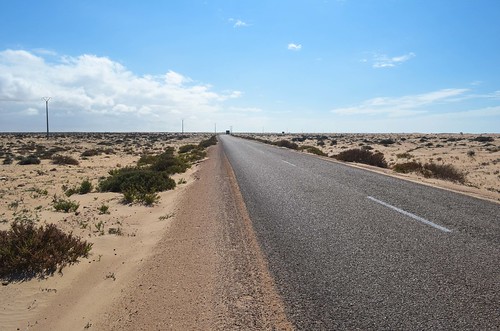
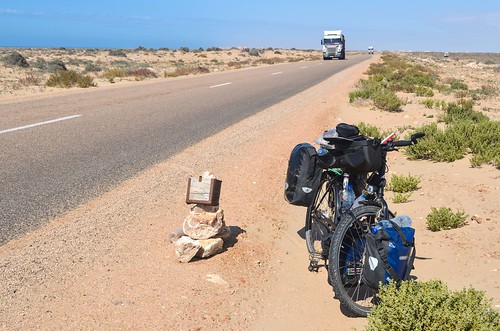
Between Tarfaya and Laayoune, I should meet the disputed border of the Western Sahara. I expect a huge border post with a strong armed presence, but there is nothing as such. The road has no more army than since Tan-Tan, no less either. It doesn’t look more or less Moroccan than before.


When I realize that I have changed my cycling gear up by 2 gears in the past hour, I understand that the wind is finally helping me, after 400 km of headwind. This creates a special feeling of happiness into me. It’s like if someone suddenly fixed the leaks of the Danaid jar. Nothing changes in my endeavor, cycling, but I feel much better about it. I get to average speeds above 25 km/h, my legs move freely and I go faster, kilometers pile up faster … The wind is not as strong as when it was against me, but just a little of it in the back makes a great difference, affecting me mentally as much as physically.
The sun comes back as well, and I feel in the mood of taking pictures too.
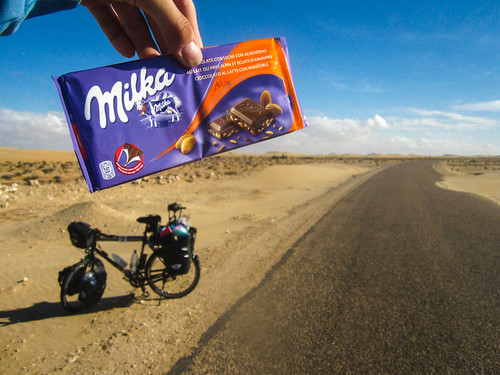
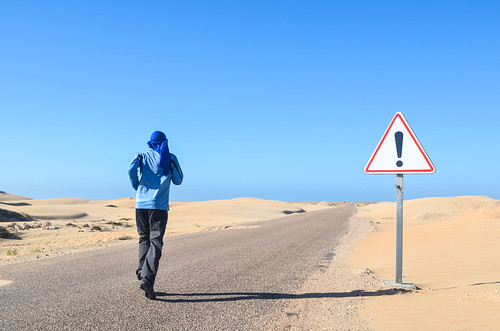
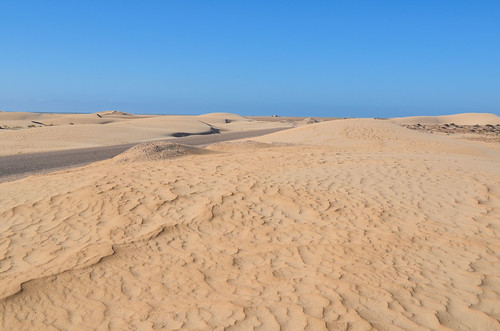
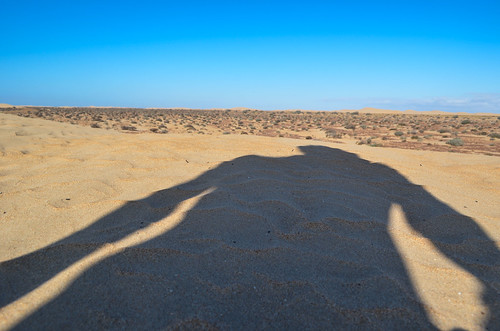
The happiness doesn’t relieve much of the self-imposed pressure to reach Laayoune, which translates into maintaining an average of 20 km/h for the 6 hours of the afternoon. Sometimes the dogs of the army posts run barking by my side. They don’t seem dangerous and as we have the same speed, I play the game of taking them as far from their home as possible.
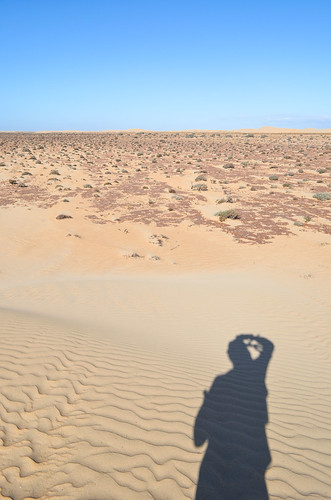
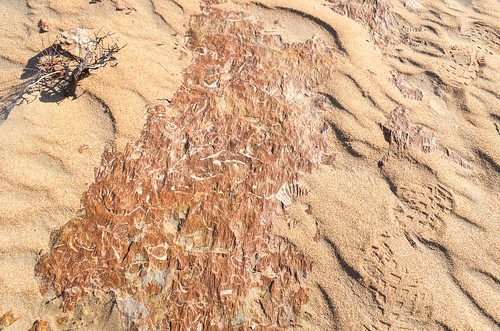
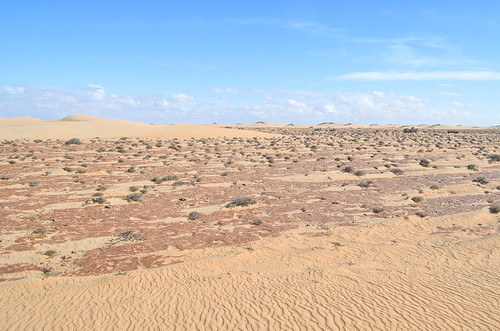

I maintain a 27 km/h average for a while into this nice scenery, between the dunes and the ocean, the army posts and the fishermen huts. There is a gendarmerie checkpoint about 30 km before Foum El Oued. They ask me where I go and don’t take my passport details down, joking that they will follow me. I joke as well telling them to take a bike and cycle with me.
But they were not joking at all. They got into their 4×4 and followed me at 25 km/h. I had the pressure of reaching Laayoune before night, and now I have the gendarmerie royale following me. They even stop just behind me when I make a chocolate break or take a picture of a camel.
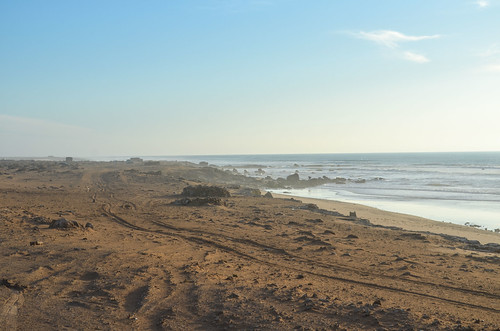
There is a last checkpoint in Foum El Oued when I join back the main road, the N1 between Laayoune and Boujdour. They tell me there are still 16 km to do until the regional capital. It is 19:00 and I already cycled more than my ambitious objective, now I just want it to stop. The gendarmerie car is still following me. Even if they spoiled a bit the nice scenery over the last 30 km, they are now very helpful because it is night and they take me until the first lights of the city (where the area is controlled by the city police and no more the gendarmerie), preventing the heavy traffic of the 2×2 lanes road to be mean to me. I finally made 160 km today, of which 130 were cycled between 1 pm and almost 8 pm . It’s 40 km more than my initial calculation, and I didn’t think taking the coastal road would make it that longer. I would have never reached this destination without the little help from the wind.
After so much of the desert, my entrance into Laayoune is almost shocking. The city is bustling, the very long road crossing it is full of lights and restaurants. The pavements are filled with people walking and drinking tea at cafés. Many of the girls are dressed in modern and attractive trends. My legs are completely dead and my hands, glove-less, are burnt (it’s a successful test).
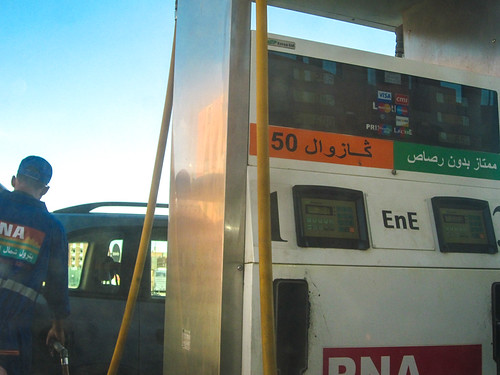
(Unfortunately for me, chocolate tablets are not subsidized)
Laayoune, or El Aaiún, a big city of 200’000, was the capital of the Spanish Sahara. It is now the capital of the Western Sahara, i.e. of the Sahrawi Arab Democratic Republic as defined by the Polisario Front, or capital of the equivalent region of Morocco, depending on how one sees things. In short, after the Spanish Franco rule weakened near 1970-1975, the inhabitants of the Sahara, the Sahrawis, led by the Polisario Front, wanted an independent country. The mandated UN gave an advice in this direction. But Morocco and Mauritania wanted to annex this huge territory with more than 1000 km of coast. This was finally made in agreement with Spain to “share” the Sahara between Morocco (two thirds) and Mauritania (one third). Against the protests and violence rising, Mauritania gave up its new region and Morocco occupied the whole Western Sahara. To deal with the opponents, Morocco sent hundred of thousands of soldiers (starting with the Green March) in the area and built the Moroccan wall, a 2700 km long border made of stones, fences and landmines, to mark the Moroccan-held Sahara from the “free zone”, a narrow band of land close to the borders with Algeria and Mauritania, where the Polisario members and Sahrawis are blocked. According to various figures, at least 100’000 Moroccan soldiers are posted there, a similar figure to the number of Sahrawis that are kept away from Morocco.
On the other hand, Morocco is investing a lot in the area, bringing money and people, and giving many advantages to the Sahrawis (that are actually a minority on their claimed land), with quotas in the administration, companies, schools, tax-free businesses, subsidized petrol and basic goods like sugar.
I have met as many pro-independence Sahrawis (mostly poor) as pro-Morocco Sahrawis (mostly with good governmental jobs). All Moroccans consider the Western Sahara as part of Morocco. In the rest of the world, some countries recognize Western Sahara, some (including the most influential) don’t. I have been told that Algeria, the legendary enemy of Morocco, and Spain, who still owns geographically surprising possessions in the Moroccan land like Ceuta, Mellila and the Canary Islands, are supporting the Polisario. On the other hand, there is France, with a priceless veto power at the UN and good business relations with Morocco. In the middle, I don’t know what is doing the the mission of the UN, the MINURSO, whose 4×4 I see often on the roads and parked in front of the few multi-star hotels of the region.
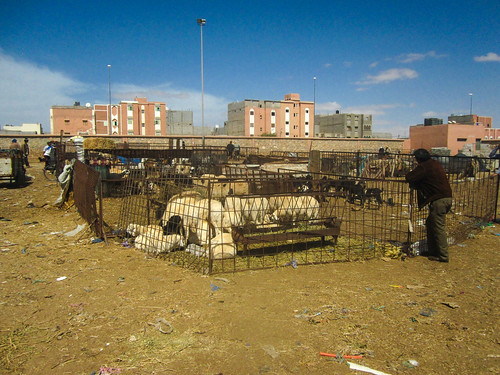
Well, there is much to discuss about the situation and I can only be inaccurate and wrong. My guess is that we’ll get a much more obvious picture of the stakes once the presence of petrol, uranium, and gold under the disputed territory will be confirmed or invalidated. From what I understood from the pro-independence Sahrawis, the resources of the land (today, fish, iron and phosphates) are enough to give a much better life to the Sahrawis if they were not managed by Moroccans. And if uranium and gold are to be found, their small population in a rich land could dream of a Dubai lifestyle.
In practice, I have not seen or felt any tension in Laayoune. The people are eating out and seemingly enjoying life. The strong army presence is not altering the tourist experience. I was guided by Abdou, with whom I have shared many interesting talks, his incredible hospitality, and camel meat. According to him, there are so many places to eat out in Laayoune because there are so many single men moving there from “mainland Morocco” for (subsidized) work or the army. The population more than doubled between 1982 and today.
After one day of rest, I can take the road again fore more desert.







Interesting reports. Relevant objective and subjective informations. I’m enjoying and learning. Thanks for sharing.
Question: I was looking for information on places where the Sahara (dunes) enters the ocean. Your photos suggest some but I wonder if you have info on a place/area in which this happens. I hear about Namibia and maybe in Egypt. Any thoughts? Thanks again
Thanks!
I don’t recall Dunes entering the ocean in Morocco/WesternSahara, as it was mostly with a cliff, and the main road separating the cliff from the sand. There must be some parts were it happens though, but high dunes is not what striked me from that road (I’ve seen more inland, e.g. near Merzouga).
In Namibia however, on the Skeleton coast and in the south, by the forbidden Sperrgebiet, it happens (but it’s much harder to get there).
Winnie The Pooh was my family’s boat. We were 3 friends trying to reach the Canaries from Morocco with a technical problem. We caught some high, beaufort 10 sea, which wasn’t anticipated by any maritime weather forecast, and after 48 hours of struggle, had to abandon, relatively close to the skeleton coast, were she now lays.
We were picked up by a Spanish rescue helicopter and flown to Lanzarote. This was covered by local Spanish TV.
Bottom line – not illegal immigration, nor smuggling 🙂
Salut JB,
Merci pour tous ces tours de pédales que tu donnes et dont tu nous fais profiter. Les lectures sont vraiment plaisantes et les photos depaysantes. Une vrai récréation, et même souvent un bain de soleil quand ici, nous nous languissons de l’arrivée du printemps (qui officiellement est aujourd’hui mais nous n’avons pas encore abandonnée les manteaux d’hiver). Continue de nous faire profiter et fais attention à toi!
Merci, j’ai dépassé la zone de confort et y’en a beaucoup trop de soleil la. En attendant l’été profite des pistes !